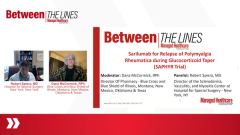
SAPHYR Study Insights and Limitations
Robert Spiera, M.D., discusses the criteria for determining the suitability of sarilumab in polymyalgia rheumatica patients, with a particular focus on indicators of steroid intolerance.
Episodes in this series

This is a video synopsis/summary of a Between the Lines involving Robert Spiera, M.D., and Dana McCormick, R.Ph.
In an informative exchange between Dana McCormick, R.Ph., and Robert Spiera, M.D., delves into patient types for whom steroids might not be appropriate in polymyalgia rheumatica treatment. Spiera highlights individuals with conditions such as brittle diabetes, steroid-related neurocognitive issues, psychosis, steroid myopathy, skin fragility, bruising and infections as high-risk patients suffering from daily steroid use. Identifying a suitable steroid dose below which a steroid-sparing agent may not be necessary poses a challenge for payers.
The conversation addresss the study’s limitations, emphasizing its complexity for nonclinical trialists and acknowledging recruitment challenges due to the pandemic. Spiera explains that the smaller-than-anticipated study size, despite hitting a statistically significant primary outcome, underscored the robustness of the intervention. However, he notes limitations in assessing certain aspects of the glucocorticoid toxicity index due to the study’s size. Despite these constraints, the study demonstrated a compelling impact of sarilumab, with potential insights left unexplored in a larger cohort.
This summary was AI-generated and reviewed by Managed Healthcare Executive® staff.
Newsletter
Get the latest industry news, event updates, and more from Managed healthcare Executive.
